16,000 Cardboard Spoons Highlight Child Hunger Crisis
La Sierra University art installation turns macaroni boxes into powerful statement on food insecurity.
Seth takes a tasting tour of UCR’s incredible collection of citrus varieties and shares some ways to sample them yourself on campus and at the upcoming Third Annual Citrus Festival at the California Citrus State Historic Park

One of the perks of my former life as a restaurant event impresario in Chicago was the ability to wangle invitations to food experiences that were not available to the general public. The most delightful of these was an invitation I managed to acquire for several years running to the premiere trade show of the candy industry: the Sweets and Snacks Expo.
Open only to media and professionals in the candy & snack industry, the Expo is, as you might expect, a smorgasbord of free candies and snacks. Sales teams from around the world descend on the convention center in Chicago to distribute samples of their candy and snack wares to attendees, in the hopes of landing distribution agreements, wholesale partners and retail outlets for their goods.
Major candy companies set up enormous and sometimes bizarre activations: Jelly Belly commissioned mosaic jelly bean art of epic proportions. Mars built castles devoted to M&Ms. Start-ups debuted new products latching on to the given year’s snack trend: bacon-flavored sunflower seeds, dill pickle-flavored potato chips, sriracha-dusted popcorn, chamoy pickles, and caffeinated chocolate bars.

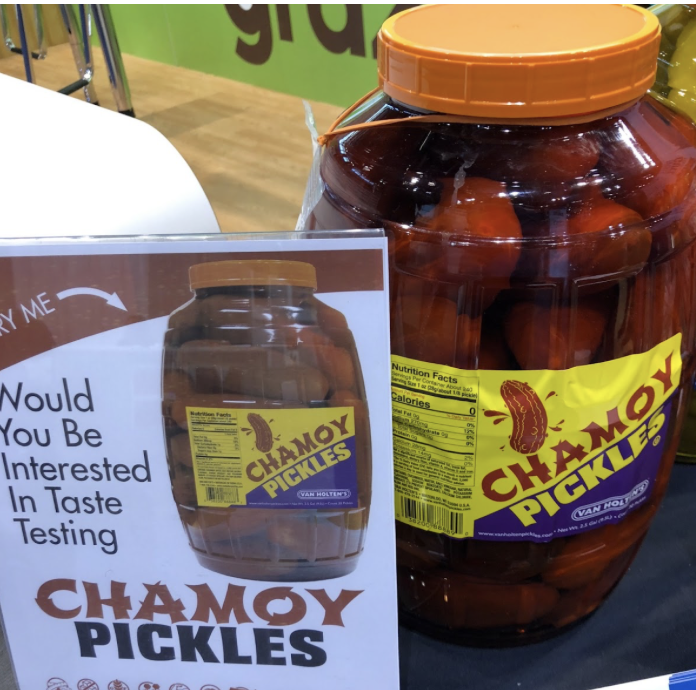
From left to right: Jelly Bean Art at the Sweets & Snacks Expo, Chamoy Pickles! (Seth Zurer)
For attendees, the Expo is like grown-up Halloween: up and down the convention floor aisles we’d go, lurching from booth to booth, grazing on chocolate and caramel and ginger chews, filling up our show-approved candy bag with samples to go.
The organizers tried to limit the acquisitive chaos by limiting attendees to one bag full of booty, but head out to the parking lot, and you’d see grown men and women surreptitiously emptying their bags into their car trunks, ready to re-enter the hall to refill again. Willy Wonka would’ve turned us all into giant blueberries, but for my candy-loving peers and me, the Expo was a peak experience, a delight, a chance to devolve into childhood again and ignore common sense and good health for a few hours of untrammeled candy pleasure. I’d come home with gallons of free candy, enough to last me for the whole year until the next show rolled around.
In Riverside, we don’t have the Sweets & Snacks Expo; parenthetically, Chicago doesn’t have it anymore either; the show moved to Indianapolis a few years back. But we do have experiences that are similarly exclusive and nearly as delightful for gourmands like me. A few weeks ago, I was lucky enough to wangle an invitation to one of these rarefied Riverside experiences. I joined a group of citrus growers, citrus lovers, and citrus researchers for an all-you-can-eat tour of the UCR Givaudan Citrus Variety Collection.

For over a hundred years, Riverside citrus researchers have collected specimens of every type of citrus plant that they can get ahold of, acquiring samples from around the world. Originally housed on land at the base of Mt. Rubidoux, the collection was moved in 1917 to fields adjacent to the Citrus Experiment Station (off Martin Luther King and Canyon Crest), where it has remained ever since. Though more than 4,000 types of citrus have been added to the “evaluation blocks” of the collection in its history, at the moment, it consists of approximately 1,050 “accessions” of citrus and related genera. Each accession is represented by two trees. The bulk of the collection lives on 25 acres of UCR agricultural fields, though there are a few acres of trees in other locations in California. It is a Noah’s Ark of citrus with a mission to “conserve and evaluate trueness-to-type for citrus and citrus relatives, to provide a resource of genetic diversity for research, and to extend knowledge about citrus diversity.”
The collection is managed by Dr. Tracy Kahn, a botanist at UCR who has been the curator since 1995, managing access to the groves, finding long-term funders for its work, and facilitating use of the specimens in industry and scientific research. Among her duties as administrator and curator is arranging and guiding tours of the collection.
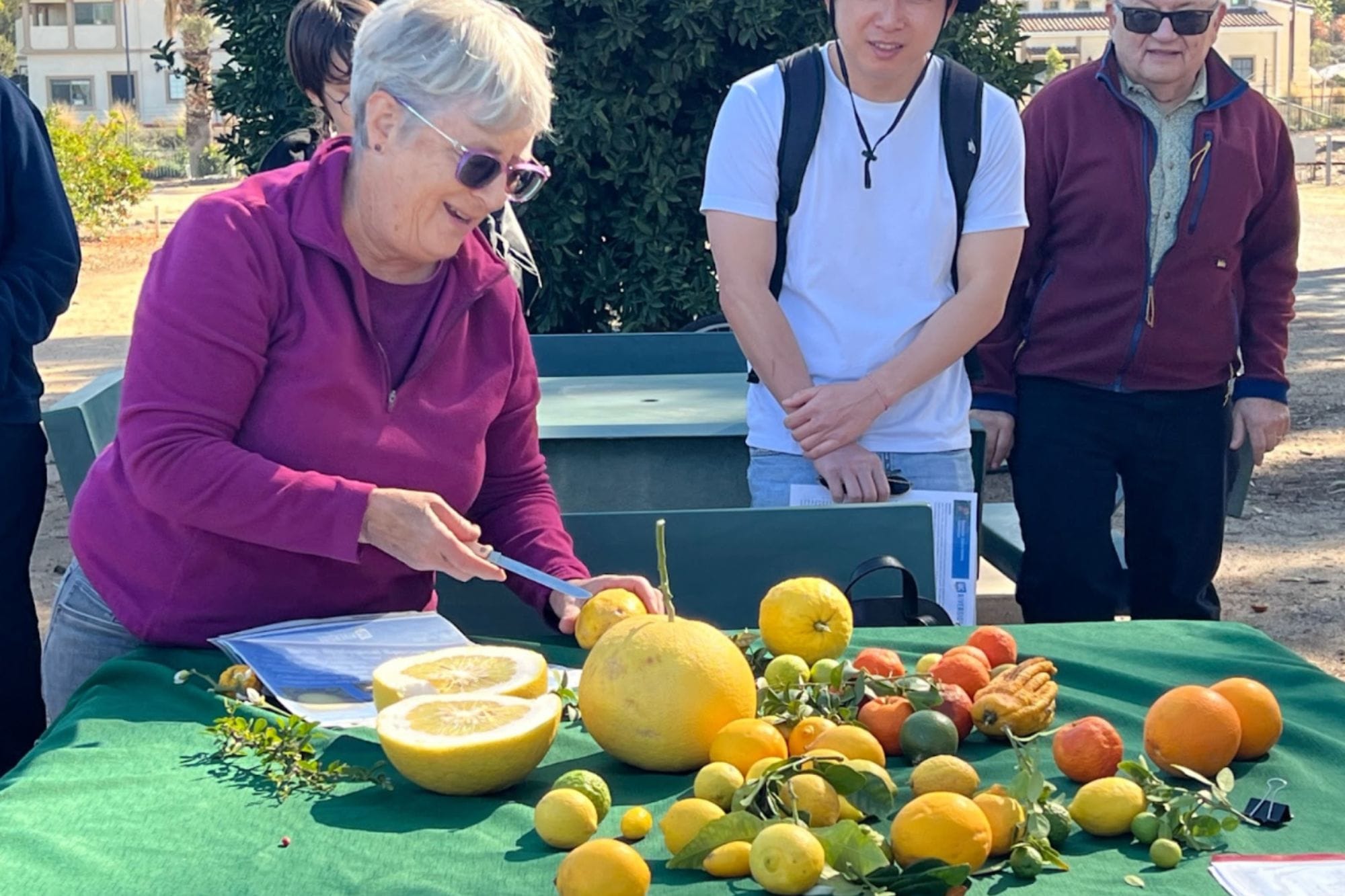
Since the main purpose of the collection is conservation and research, it is not open to the general public. Tours are by request only and are infrequently granted to folks who are not part of the academic citrus research community or connected to the citrus industry or to the strategic goals of the collection.
The collection bears the name Givaudan in recognition of the financial support that it has received from this Swiss company. According to their website, Givaudan is a “global industry leader creating game-changing innovations in food and beverages as well as inspiring creations in the world of scent and beauty”. Representatives from Givaudan and their guests are among the most frequently accommodated visitors to the collection, drawing inspiration from the enormous variety of citrus fruit available on site.
The tour I joined (in my capacity as Food & Dining Correspondent for the Gazette) was populated by a few citrus enthusiasts, some members of the staff from the Citrus State Historical Park, some home growers and gardeners, and a smattering of UCR undergrads, grad students, and postdocs. Everyone was excited to be there - a florist from LA told me she’d been emailing Tracy for years after having seen her and the collection on an episode of California’s Gold on PBS in 1998.
First, we gathered around a table, groaning with samples from the fields, and received a quick introduction to the citrus genealogy and the history of the collection. Tracy talked to us about some of the current risks to citrus farming that affect the collection and pointed out the CUPS (Citrus Under Protection System) at the other end of the field, a mesh-enclosed area designed to protect plants from infestation with dangerous pests like the citrus psyllid that carries the dreaded HLB virus.
And then we got right down to business, first tasting samples brought into our picnic table from other areas of the collection and then off into the groves where we tasted fruit after fruit right off the tree. Tracy carried a binder with a map of the trees in the fields - there are no placards or other labels to identify trees - and guided us to particularly interesting varieties. A partial list of fruit we tasted: rangpur limes, red pulp finger limes with a shocking purple rind, tangomandarins, chinotto bitter oranges, fragrant bergamotto fantastico, sugary meiwa kumquat, acidless vaniglia sanguinoblood oranges and clean sweet Smith red blood oranges, astringent Rojo Blanco pummelos, the venerable Duncan and flirtatious Rio Red grapefruit, candy-like seedless Kishu and juicy Gold Nugget mandarins, Wekiwa sweet orange tangelos, and brilliant orange lumpy oblate Ugli fruit.
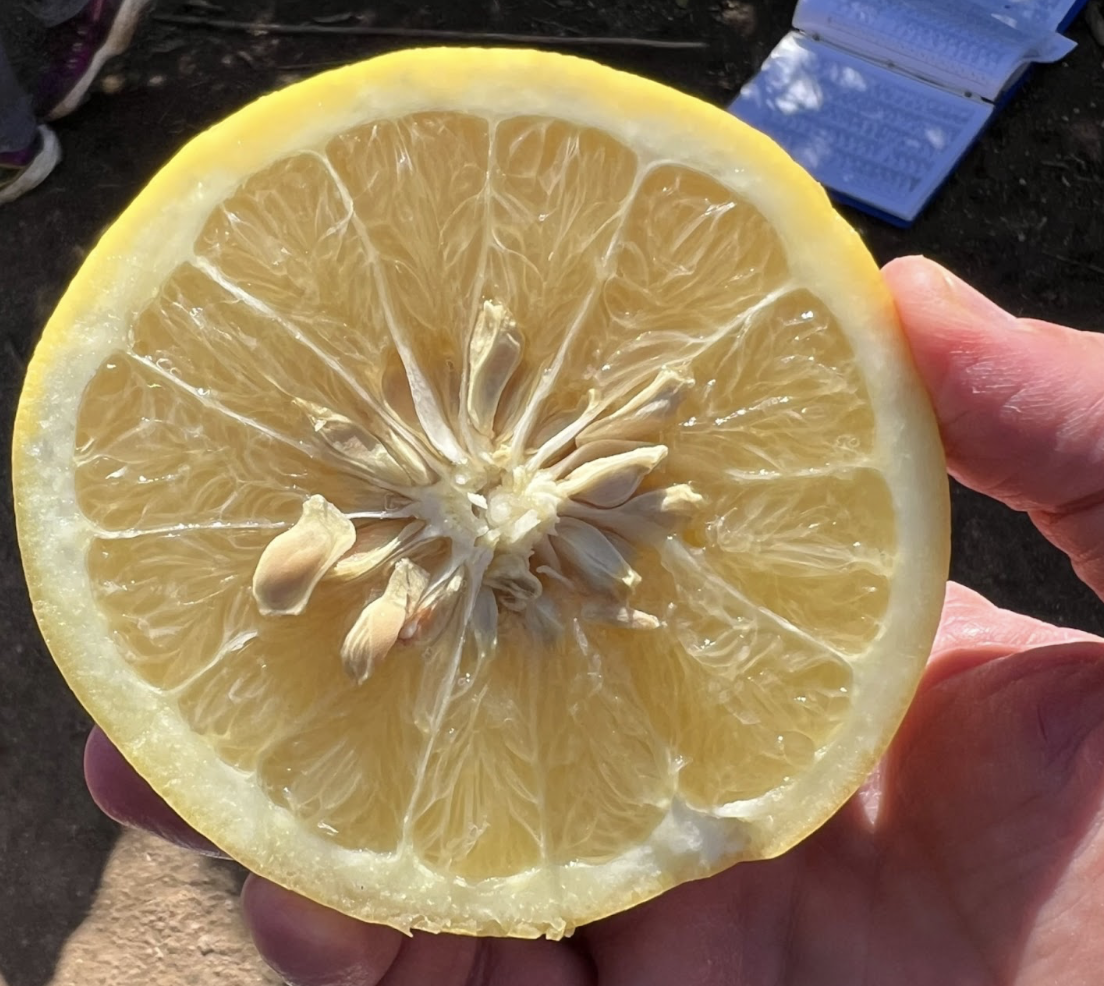
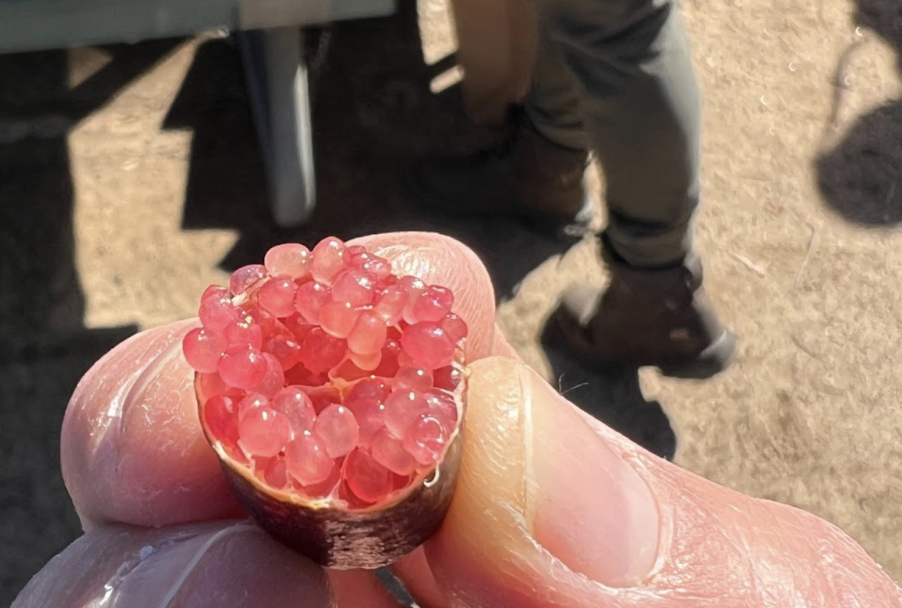
From left to right: Cross section of a grapefruit at the Citrus Variety Colleciton, Squeezing Australian red pulp finger limes. (Seth Zurer)

At first, we all waited patiently for Tracy to introduce each fruit and to slice off samples for us to taste. As the tour went on, discipline slipped, and people snagged oranges and lemons and tangelos on their own recognizance as walking past trees, eager to try everything, even if we didn’t know what it was. I could’ve spent all day exploring the collection. The fruit we tried ranged from sickly sweet to eye-wateringly tart. We tried oranges from every corner of the color spectrum, with brilliant ruby red to pale yellow flesh. Our hands and faces got sticky with juice. It was, in short, a delight.
If you ever have the opportunity to join a tour of the collection, I highly recommend it. If not, there are a few places in Riverside where you can get a similar experience.
Several of the collection’s varieties are used in food available for purchase on the UCR campus.
Scoops, the ice cream shop in the HUB (Highlander Union Building), features a rotating selection of ice cream flavors that make use of products from the University’s various agricultural programs. As of writing, there was a matcha-Yuzu ice cream available featuring Yuzu juice from the Givaudan collection, as well as a honey pistachio ice cream with honey from the hives on campus.
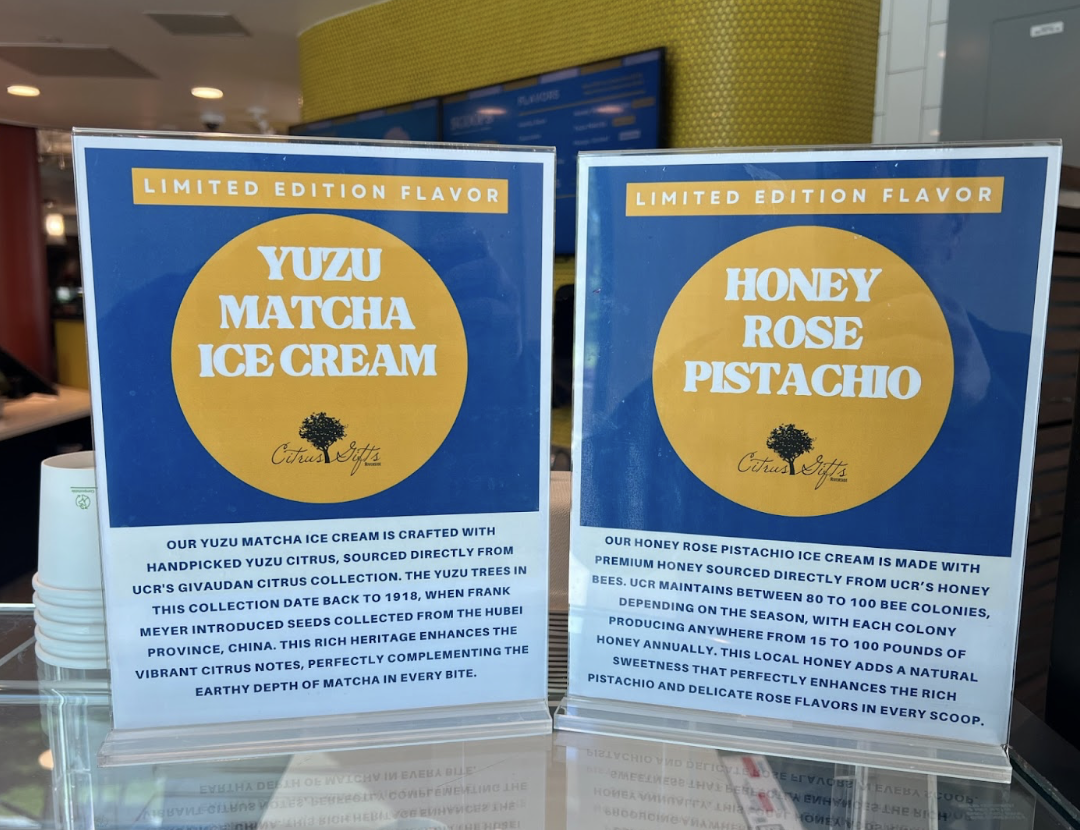
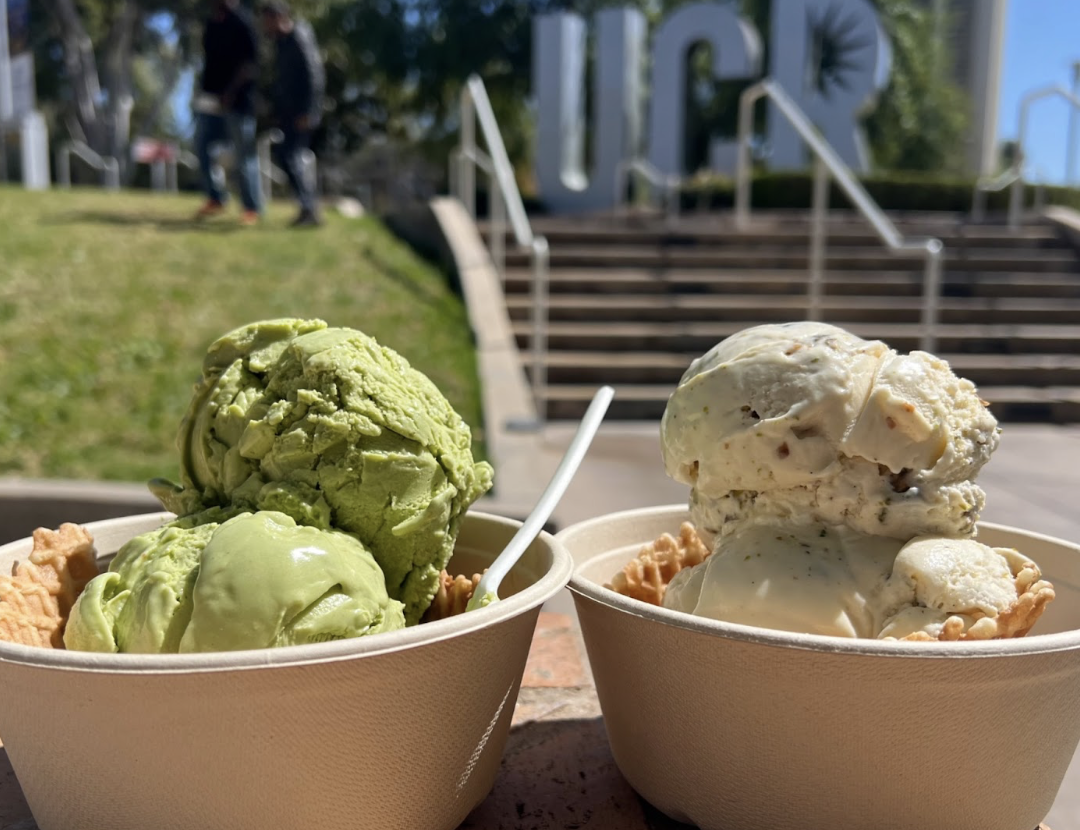
From left to right: Rotating flavors at Scoops ice cream shop in the Highlander Union Building at UCR, Yuzu-matcha ice cream and honey-pistachio ice cream, made with products from UCR’s agricultural programs. (Seth Zurer)
UCR’s food service department collaborates with Coney Island Creamery to produce new ice cream flavors every season. Coming this fall, you can expect to see Blood Orange Vanilla ice cream that uses juice from the collection’s Boukouzhba blood orange specimens. The Stable, UCR’s full-service restaurant/bar adjacent to the Barn, offers Bergamot Dream ice cream made with Citrus Collection juice. And Kurt Duffner, the director of retail and restaurants for UCR, says that they’re about to start to offer pre-packaged 4-oz servings of orange chocolate and orange vanilla ice cream from the freezer cases in the various Scotty’s C-Store locations on campus.
If ice cream is not your jam, consider jam instead. UCR offers marmalade made from citrus grown in the collection through their “Citrus Gift Collection” line of products, available from displays on campus in The Barn, The Market at Glen Mor, and the Scotty’s store at the HUB, as well as online. I tried the Seville orange and clementine/mandarin marmalades and can happily pronounce them delicious. Also available through the Citrus Gift collection - lip balms, soaps, oils, and vinegars, all containing citrus essence from fruit grown in the Givaudan orchards.
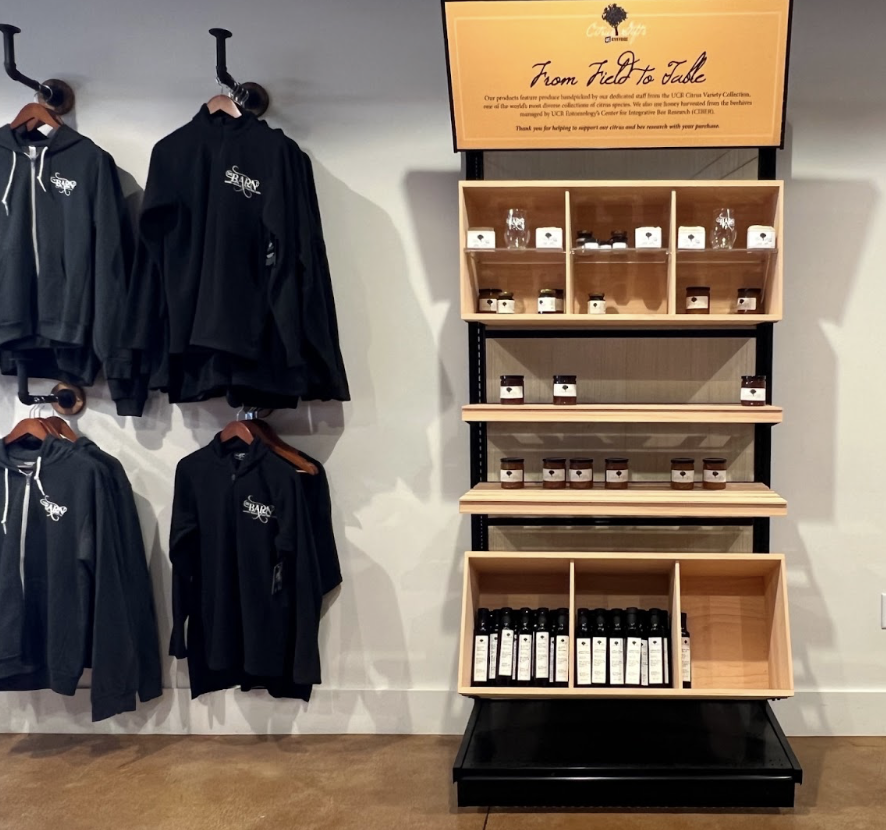
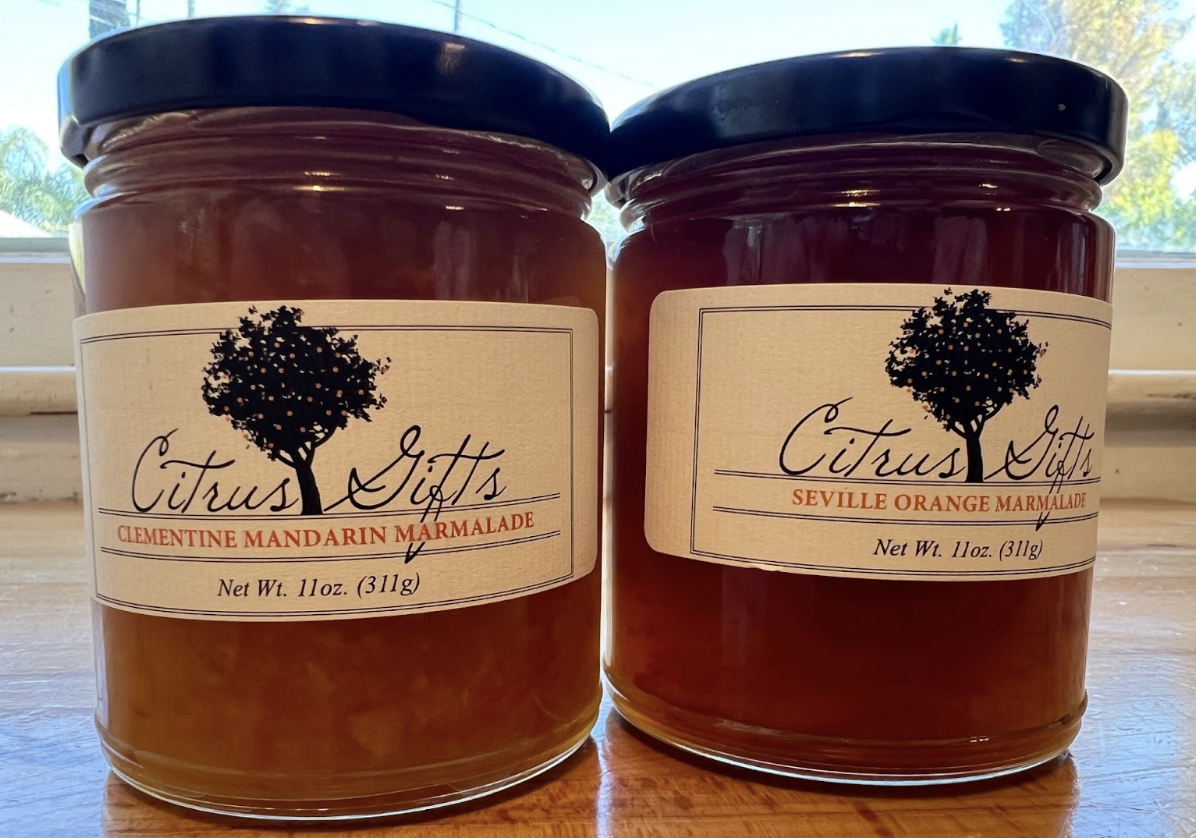
From left to right: A display of Citrus Collection Gifts at the Barn on the UCR campus, Clementine-Orange marmalade and Seville Orange Marmalade from the UCR Citrus Gifts Collection. (Seth Zurer)
Finally, Duffner reminded me, there is also citrus-flavored beer made with UCR fruit (brewed in partnership with Iron Fire Brewery) available on tap at the Stable. If you ever come down to challenge my trivia team during the weekly Stable pub quiz (Tuesday nights at 5:30pm), you can give it a try.
That’s all well and good, but it doesn’t compare to the experience of sampling all these different citrus varieties right off the tree.
The closest you can get to that Wonka-esque experience is at the Third Annual Citrus Festival, conveniently coming up on April 5, 2025 at the California Citrus State Historic Park. You can go as an attendee and sample citrus from the park’s groves, or you can volunteer to help staff the festival. Sign-ups are now open online for jobs in the lead-up to the festival (such as picking fruit and cutting it up for samples) as well as on the day of the event.
For more info on the Givaudan Citrus Variety Collection at UCR, check out their website, which offers a wealth of information on the accessions in the collection as well as the research that the collection supports.
For details about the Citrus Gift Collection at UCR and to mail order marmalade or other treats, visit their website.
Let us email you Riverside's news and events every Sunday, Monday, Wednesday, and Friday morning. For free